Macro Environmental Analysis for Strategic Management Decisions
VerifiedAdded on 2023/01/11
|17
|4471
|27
AI Summary
This study explores the macro environmental factors that impact strategic management decisions and provides insights on how external factors affect firm strategies. It also evaluates the internal environment and justifies appropriate strategies for competitive benefits.
Contribute Materials
Your contribution can guide someone’s learning journey. Share your
documents today.
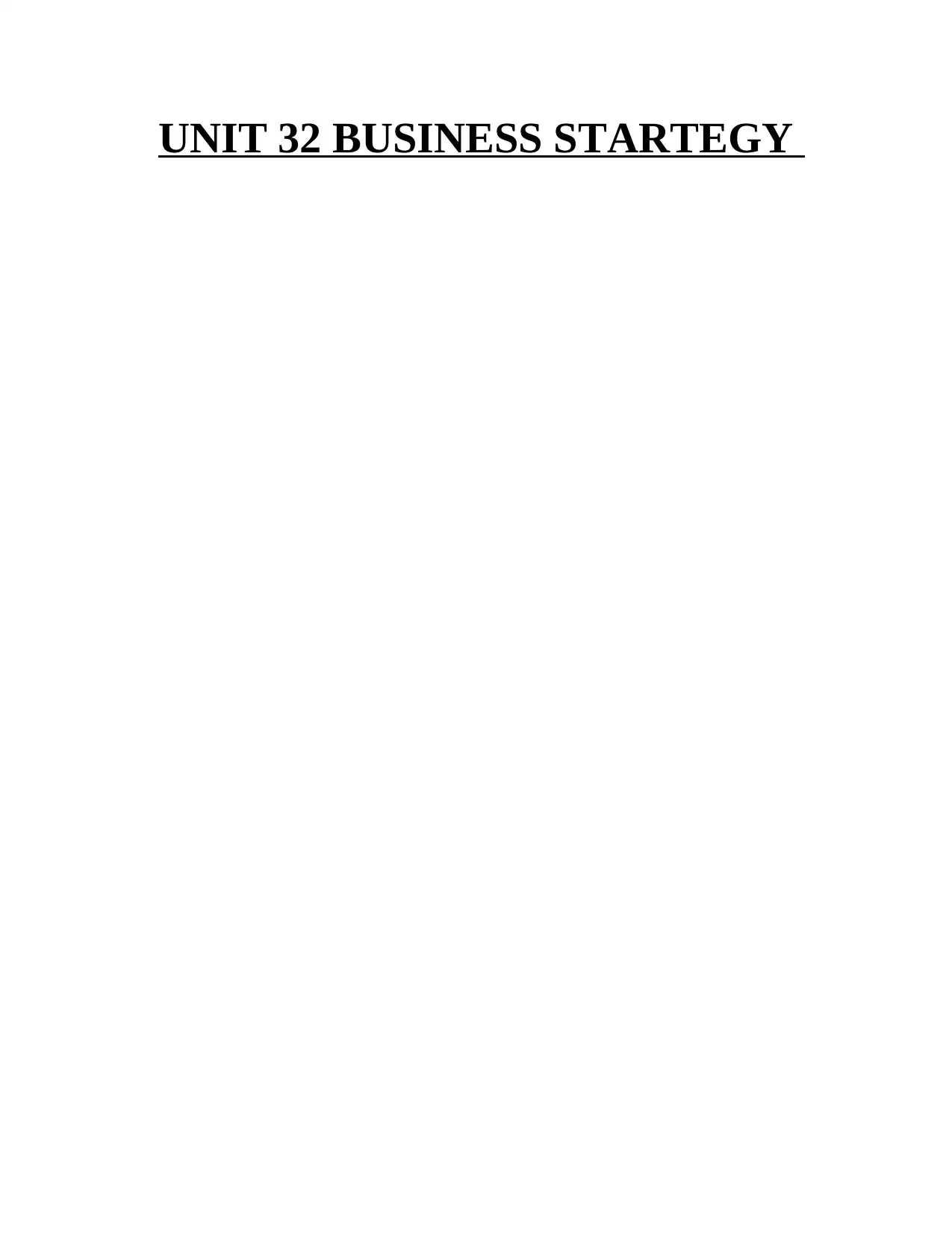
UNIT 32 BUSINESS STARTEGY
Secure Best Marks with AI Grader
Need help grading? Try our AI Grader for instant feedback on your assignments.

Table of Contents
INTRODUCTION...........................................................................................................................2
TASK 1............................................................................................................................................2
Macro environmental analysis to identify and inform strategic management decisions.............2
Internal environment that consider company internal abilities, culture and business practices. .6
Evaluation of competitive market by using Porter’s five forces model.......................................9
Models, theories and concepts to project strategic management plan.......................................10
CONCLUSION..............................................................................................................................15
REFERENCES..............................................................................................................................16
INTRODUCTION...........................................................................................................................2
TASK 1............................................................................................................................................2
Macro environmental analysis to identify and inform strategic management decisions.............2
Internal environment that consider company internal abilities, culture and business practices. .6
Evaluation of competitive market by using Porter’s five forces model.......................................9
Models, theories and concepts to project strategic management plan.......................................10
CONCLUSION..............................................................................................................................15
REFERENCES..............................................................................................................................16
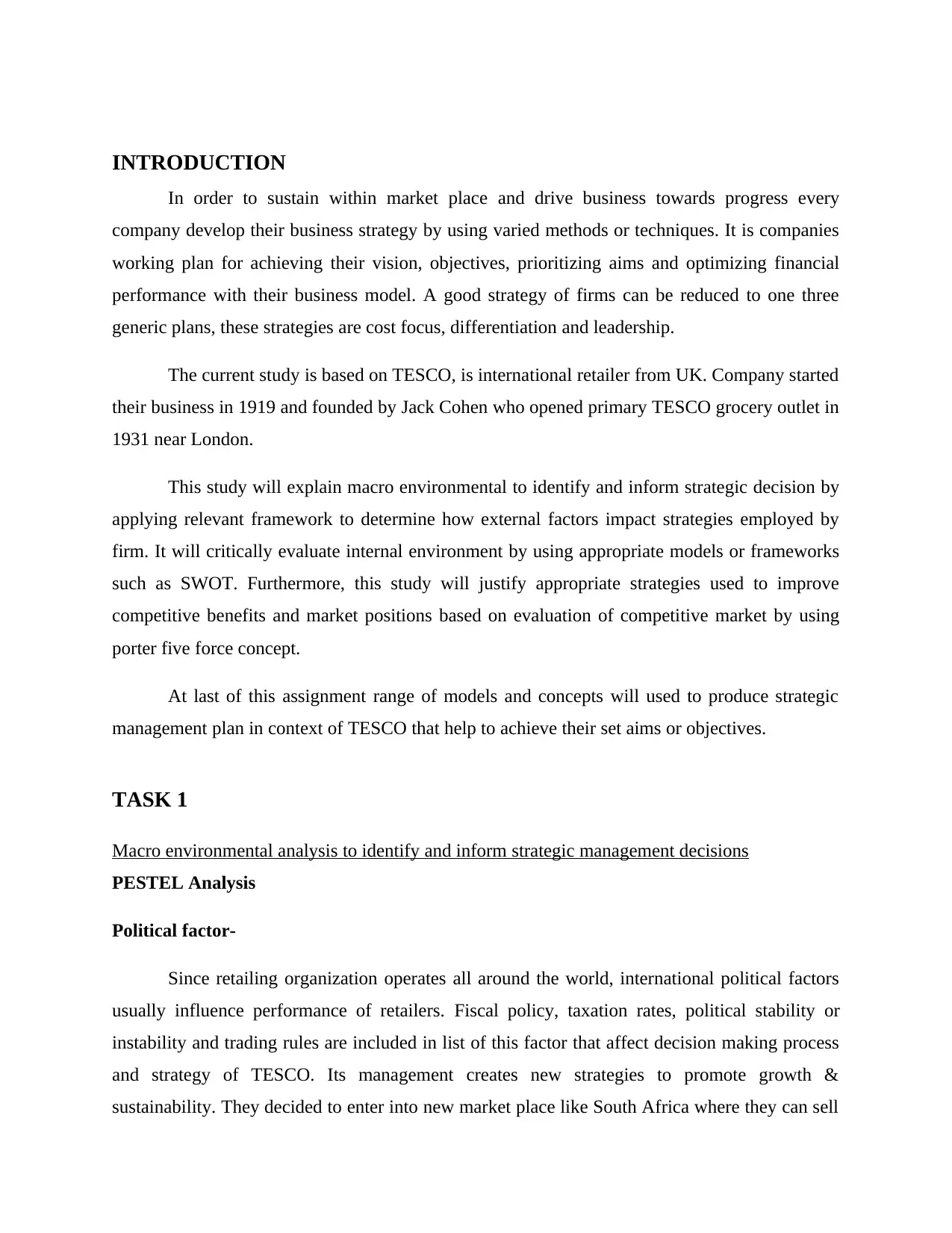
INTRODUCTION
In order to sustain within market place and drive business towards progress every
company develop their business strategy by using varied methods or techniques. It is companies
working plan for achieving their vision, objectives, prioritizing aims and optimizing financial
performance with their business model. A good strategy of firms can be reduced to one three
generic plans, these strategies are cost focus, differentiation and leadership.
The current study is based on TESCO, is international retailer from UK. Company started
their business in 1919 and founded by Jack Cohen who opened primary TESCO grocery outlet in
1931 near London.
This study will explain macro environmental to identify and inform strategic decision by
applying relevant framework to determine how external factors impact strategies employed by
firm. It will critically evaluate internal environment by using appropriate models or frameworks
such as SWOT. Furthermore, this study will justify appropriate strategies used to improve
competitive benefits and market positions based on evaluation of competitive market by using
porter five force concept.
At last of this assignment range of models and concepts will used to produce strategic
management plan in context of TESCO that help to achieve their set aims or objectives.
TASK 1
Macro environmental analysis to identify and inform strategic management decisions
PESTEL Analysis
Political factor-
Since retailing organization operates all around the world, international political factors
usually influence performance of retailers. Fiscal policy, taxation rates, political stability or
instability and trading rules are included in list of this factor that affect decision making process
and strategy of TESCO. Its management creates new strategies to promote growth &
sustainability. They decided to enter into new market place like South Africa where they can sell
In order to sustain within market place and drive business towards progress every
company develop their business strategy by using varied methods or techniques. It is companies
working plan for achieving their vision, objectives, prioritizing aims and optimizing financial
performance with their business model. A good strategy of firms can be reduced to one three
generic plans, these strategies are cost focus, differentiation and leadership.
The current study is based on TESCO, is international retailer from UK. Company started
their business in 1919 and founded by Jack Cohen who opened primary TESCO grocery outlet in
1931 near London.
This study will explain macro environmental to identify and inform strategic decision by
applying relevant framework to determine how external factors impact strategies employed by
firm. It will critically evaluate internal environment by using appropriate models or frameworks
such as SWOT. Furthermore, this study will justify appropriate strategies used to improve
competitive benefits and market positions based on evaluation of competitive market by using
porter five force concept.
At last of this assignment range of models and concepts will used to produce strategic
management plan in context of TESCO that help to achieve their set aims or objectives.
TASK 1
Macro environmental analysis to identify and inform strategic management decisions
PESTEL Analysis
Political factor-
Since retailing organization operates all around the world, international political factors
usually influence performance of retailers. Fiscal policy, taxation rates, political stability or
instability and trading rules are included in list of this factor that affect decision making process
and strategy of TESCO. Its management creates new strategies to promote growth &
sustainability. They decided to enter into new market place like South Africa where they can sell
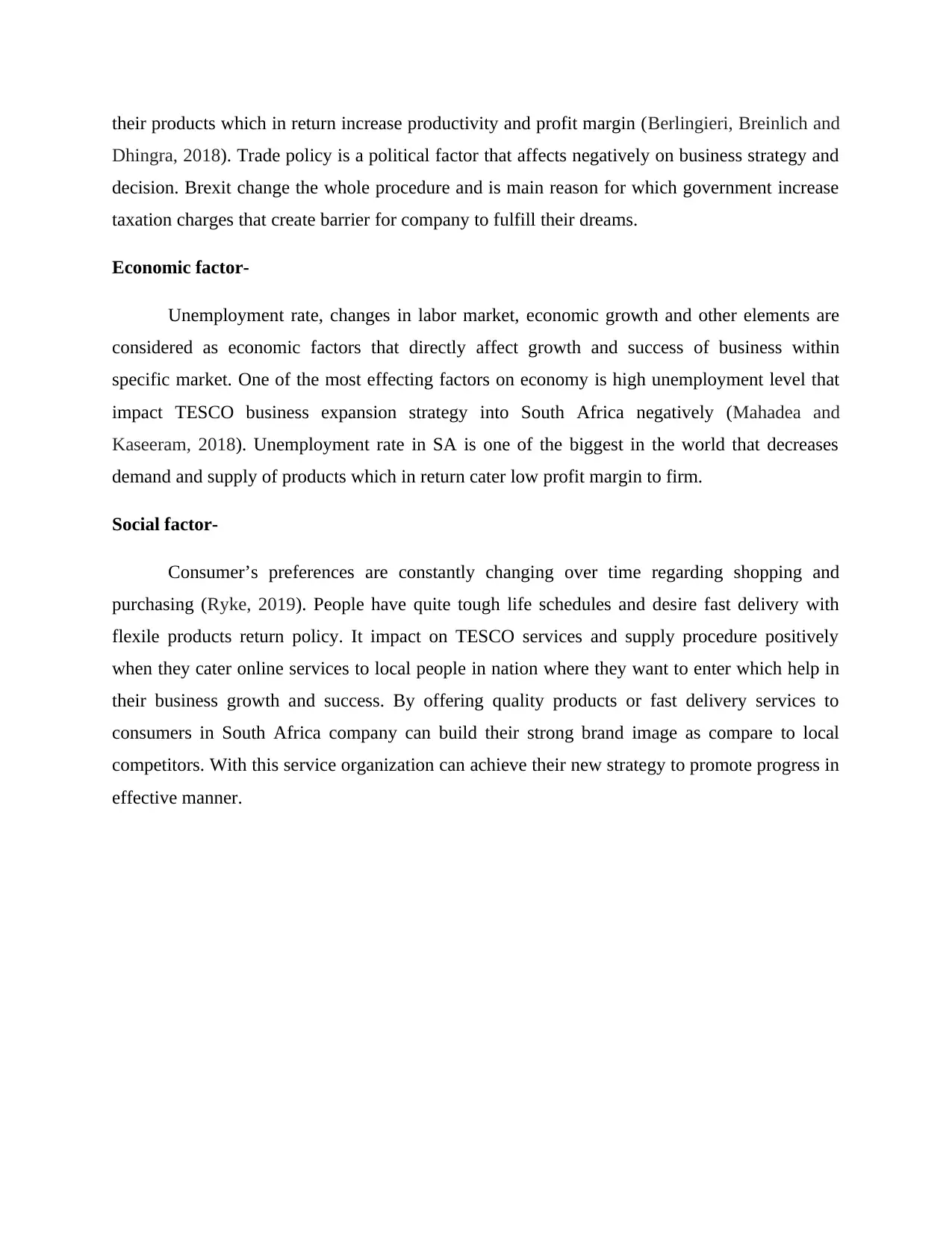
their products which in return increase productivity and profit margin (Berlingieri, Breinlich and
Dhingra, 2018). Trade policy is a political factor that affects negatively on business strategy and
decision. Brexit change the whole procedure and is main reason for which government increase
taxation charges that create barrier for company to fulfill their dreams.
Economic factor-
Unemployment rate, changes in labor market, economic growth and other elements are
considered as economic factors that directly affect growth and success of business within
specific market. One of the most effecting factors on economy is high unemployment level that
impact TESCO business expansion strategy into South Africa negatively (Mahadea and
Kaseeram, 2018). Unemployment rate in SA is one of the biggest in the world that decreases
demand and supply of products which in return cater low profit margin to firm.
Social factor-
Consumer’s preferences are constantly changing over time regarding shopping and
purchasing (Ryke, 2019). People have quite tough life schedules and desire fast delivery with
flexile products return policy. It impact on TESCO services and supply procedure positively
when they cater online services to local people in nation where they want to enter which help in
their business growth and success. By offering quality products or fast delivery services to
consumers in South Africa company can build their strong brand image as compare to local
competitors. With this service organization can achieve their new strategy to promote progress in
effective manner.
Dhingra, 2018). Trade policy is a political factor that affects negatively on business strategy and
decision. Brexit change the whole procedure and is main reason for which government increase
taxation charges that create barrier for company to fulfill their dreams.
Economic factor-
Unemployment rate, changes in labor market, economic growth and other elements are
considered as economic factors that directly affect growth and success of business within
specific market. One of the most effecting factors on economy is high unemployment level that
impact TESCO business expansion strategy into South Africa negatively (Mahadea and
Kaseeram, 2018). Unemployment rate in SA is one of the biggest in the world that decreases
demand and supply of products which in return cater low profit margin to firm.
Social factor-
Consumer’s preferences are constantly changing over time regarding shopping and
purchasing (Ryke, 2019). People have quite tough life schedules and desire fast delivery with
flexile products return policy. It impact on TESCO services and supply procedure positively
when they cater online services to local people in nation where they want to enter which help in
their business growth and success. By offering quality products or fast delivery services to
consumers in South Africa company can build their strong brand image as compare to local
competitors. With this service organization can achieve their new strategy to promote progress in
effective manner.
Secure Best Marks with AI Grader
Need help grading? Try our AI Grader for instant feedback on your assignments.
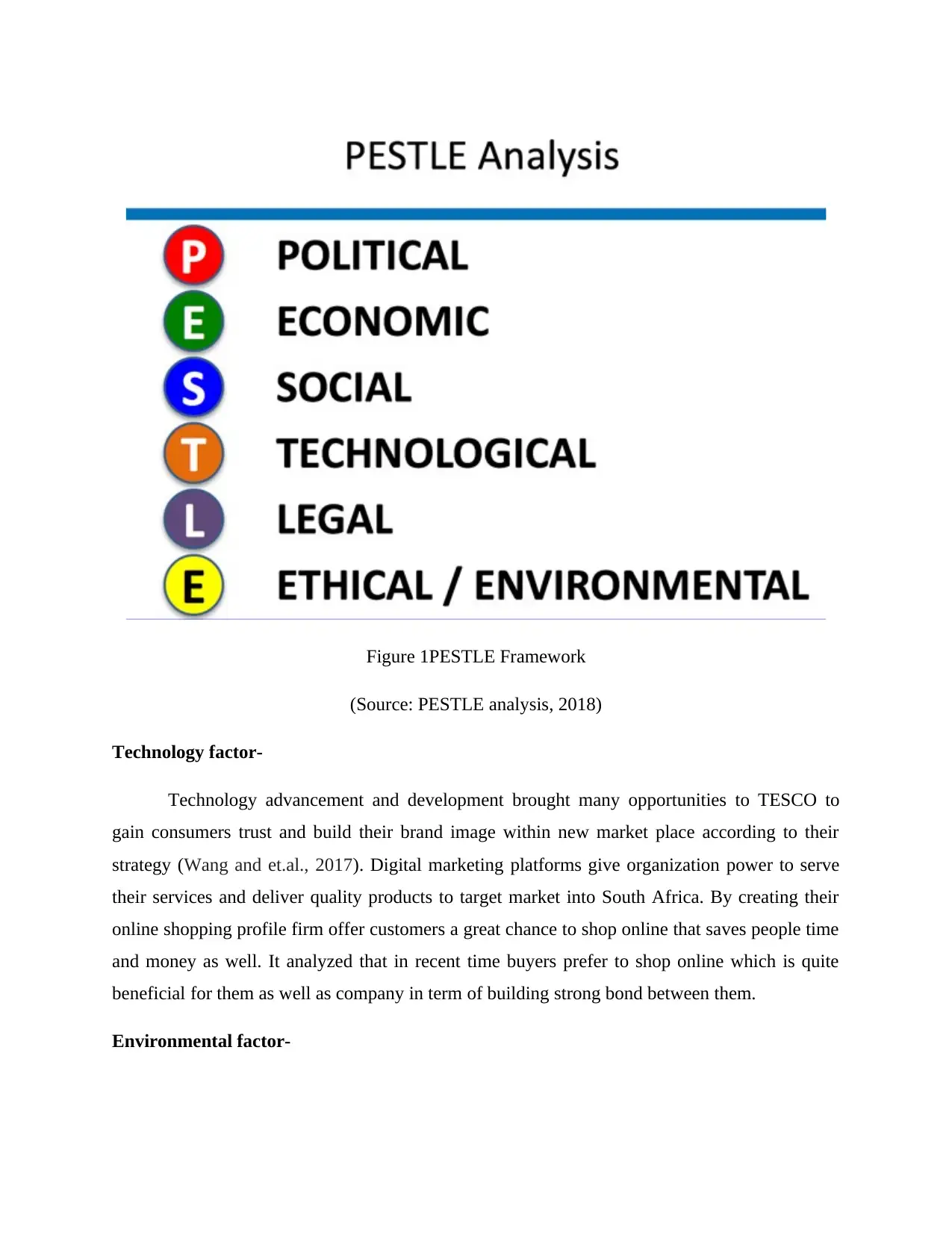
Figure 1PESTLE Framework
(Source: PESTLE analysis, 2018)
Technology factor-
Technology advancement and development brought many opportunities to TESCO to
gain consumers trust and build their brand image within new market place according to their
strategy (Wang and et.al., 2017). Digital marketing platforms give organization power to serve
their services and deliver quality products to target market into South Africa. By creating their
online shopping profile firm offer customers a great chance to shop online that saves people time
and money as well. It analyzed that in recent time buyers prefer to shop online which is quite
beneficial for them as well as company in term of building strong bond between them.
Environmental factor-
(Source: PESTLE analysis, 2018)
Technology factor-
Technology advancement and development brought many opportunities to TESCO to
gain consumers trust and build their brand image within new market place according to their
strategy (Wang and et.al., 2017). Digital marketing platforms give organization power to serve
their services and deliver quality products to target market into South Africa. By creating their
online shopping profile firm offer customers a great chance to shop online that saves people time
and money as well. It analyzed that in recent time buyers prefer to shop online which is quite
beneficial for them as well as company in term of building strong bond between them.
Environmental factor-
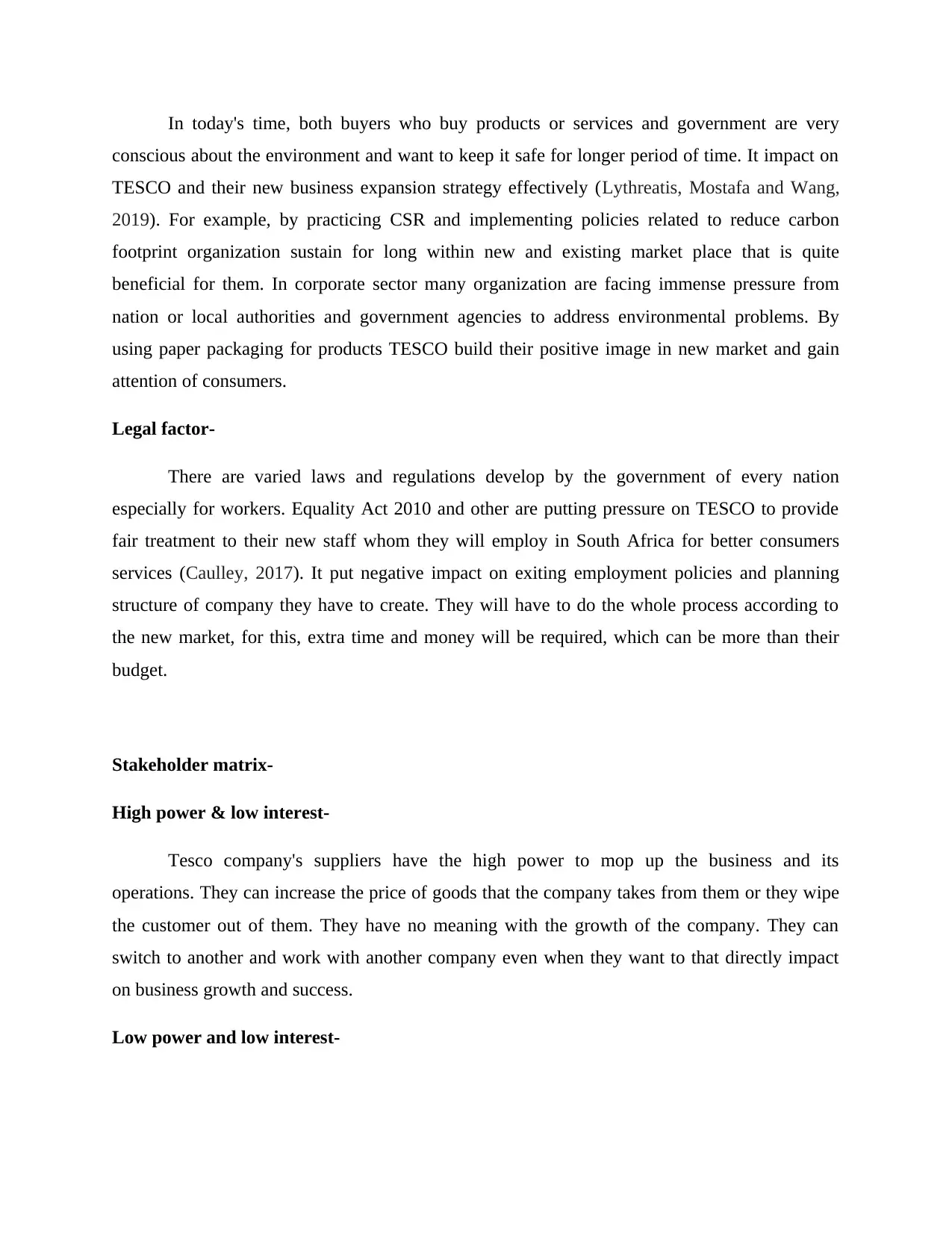
In today's time, both buyers who buy products or services and government are very
conscious about the environment and want to keep it safe for longer period of time. It impact on
TESCO and their new business expansion strategy effectively (Lythreatis, Mostafa and Wang,
2019). For example, by practicing CSR and implementing policies related to reduce carbon
footprint organization sustain for long within new and existing market place that is quite
beneficial for them. In corporate sector many organization are facing immense pressure from
nation or local authorities and government agencies to address environmental problems. By
using paper packaging for products TESCO build their positive image in new market and gain
attention of consumers.
Legal factor-
There are varied laws and regulations develop by the government of every nation
especially for workers. Equality Act 2010 and other are putting pressure on TESCO to provide
fair treatment to their new staff whom they will employ in South Africa for better consumers
services (Caulley, 2017). It put negative impact on exiting employment policies and planning
structure of company they have to create. They will have to do the whole process according to
the new market, for this, extra time and money will be required, which can be more than their
budget.
Stakeholder matrix-
High power & low interest-
Tesco company's suppliers have the high power to mop up the business and its
operations. They can increase the price of goods that the company takes from them or they wipe
the customer out of them. They have no meaning with the growth of the company. They can
switch to another and work with another company even when they want to that directly impact
on business growth and success.
Low power and low interest-
conscious about the environment and want to keep it safe for longer period of time. It impact on
TESCO and their new business expansion strategy effectively (Lythreatis, Mostafa and Wang,
2019). For example, by practicing CSR and implementing policies related to reduce carbon
footprint organization sustain for long within new and existing market place that is quite
beneficial for them. In corporate sector many organization are facing immense pressure from
nation or local authorities and government agencies to address environmental problems. By
using paper packaging for products TESCO build their positive image in new market and gain
attention of consumers.
Legal factor-
There are varied laws and regulations develop by the government of every nation
especially for workers. Equality Act 2010 and other are putting pressure on TESCO to provide
fair treatment to their new staff whom they will employ in South Africa for better consumers
services (Caulley, 2017). It put negative impact on exiting employment policies and planning
structure of company they have to create. They will have to do the whole process according to
the new market, for this, extra time and money will be required, which can be more than their
budget.
Stakeholder matrix-
High power & low interest-
Tesco company's suppliers have the high power to mop up the business and its
operations. They can increase the price of goods that the company takes from them or they wipe
the customer out of them. They have no meaning with the growth of the company. They can
switch to another and work with another company even when they want to that directly impact
on business growth and success.
Low power and low interest-
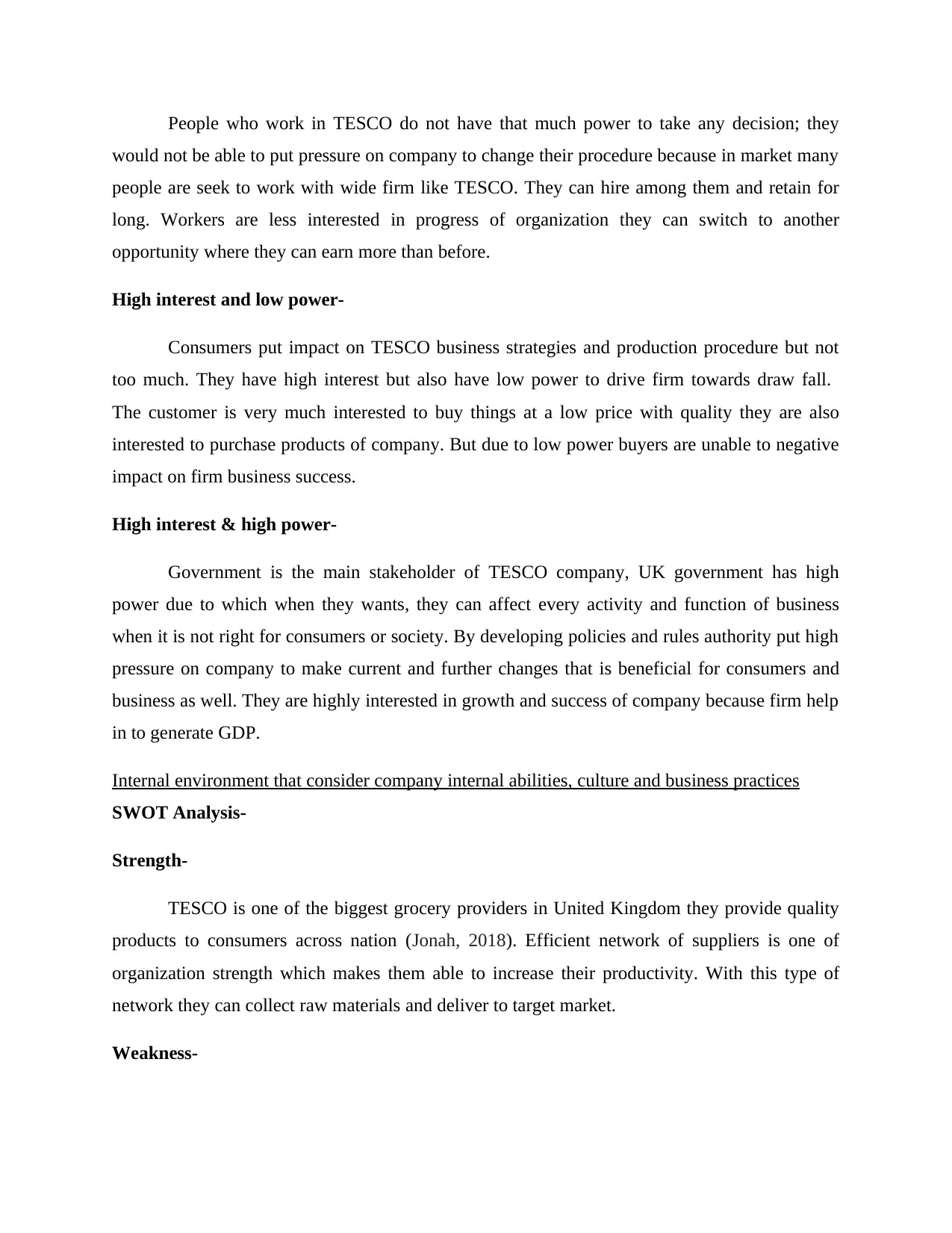
People who work in TESCO do not have that much power to take any decision; they
would not be able to put pressure on company to change their procedure because in market many
people are seek to work with wide firm like TESCO. They can hire among them and retain for
long. Workers are less interested in progress of organization they can switch to another
opportunity where they can earn more than before.
High interest and low power-
Consumers put impact on TESCO business strategies and production procedure but not
too much. They have high interest but also have low power to drive firm towards draw fall.
The customer is very much interested to buy things at a low price with quality they are also
interested to purchase products of company. But due to low power buyers are unable to negative
impact on firm business success.
High interest & high power-
Government is the main stakeholder of TESCO company, UK government has high
power due to which when they wants, they can affect every activity and function of business
when it is not right for consumers or society. By developing policies and rules authority put high
pressure on company to make current and further changes that is beneficial for consumers and
business as well. They are highly interested in growth and success of company because firm help
in to generate GDP.
Internal environment that consider company internal abilities, culture and business practices
SWOT Analysis-
Strength-
TESCO is one of the biggest grocery providers in United Kingdom they provide quality
products to consumers across nation (Jonah, 2018). Efficient network of suppliers is one of
organization strength which makes them able to increase their productivity. With this type of
network they can collect raw materials and deliver to target market.
Weakness-
would not be able to put pressure on company to change their procedure because in market many
people are seek to work with wide firm like TESCO. They can hire among them and retain for
long. Workers are less interested in progress of organization they can switch to another
opportunity where they can earn more than before.
High interest and low power-
Consumers put impact on TESCO business strategies and production procedure but not
too much. They have high interest but also have low power to drive firm towards draw fall.
The customer is very much interested to buy things at a low price with quality they are also
interested to purchase products of company. But due to low power buyers are unable to negative
impact on firm business success.
High interest & high power-
Government is the main stakeholder of TESCO company, UK government has high
power due to which when they wants, they can affect every activity and function of business
when it is not right for consumers or society. By developing policies and rules authority put high
pressure on company to make current and further changes that is beneficial for consumers and
business as well. They are highly interested in growth and success of company because firm help
in to generate GDP.
Internal environment that consider company internal abilities, culture and business practices
SWOT Analysis-
Strength-
TESCO is one of the biggest grocery providers in United Kingdom they provide quality
products to consumers across nation (Jonah, 2018). Efficient network of suppliers is one of
organization strength which makes them able to increase their productivity. With this type of
network they can collect raw materials and deliver to target market.
Weakness-
Paraphrase This Document
Need a fresh take? Get an instant paraphrase of this document with our AI Paraphraser
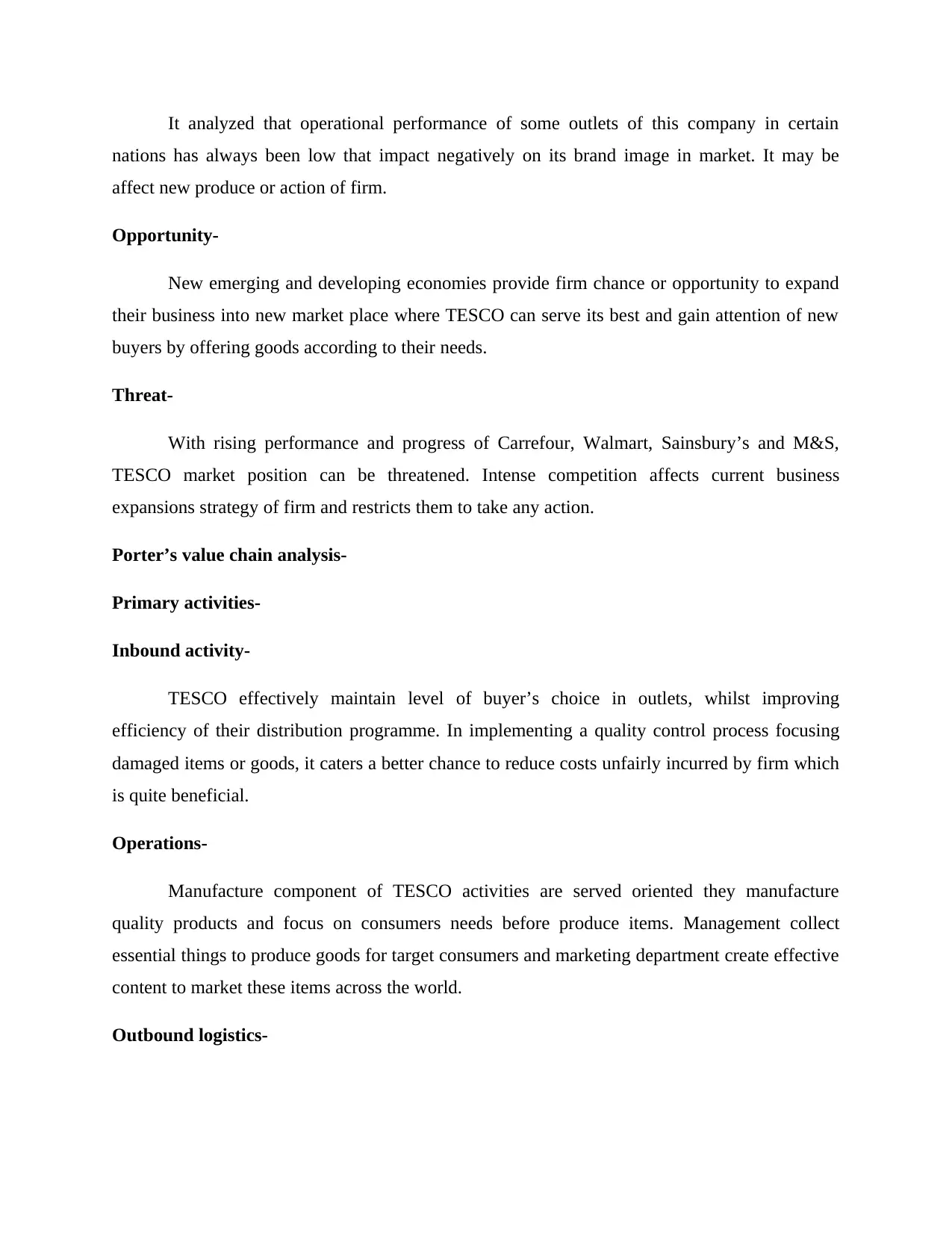
It analyzed that operational performance of some outlets of this company in certain
nations has always been low that impact negatively on its brand image in market. It may be
affect new produce or action of firm.
Opportunity-
New emerging and developing economies provide firm chance or opportunity to expand
their business into new market place where TESCO can serve its best and gain attention of new
buyers by offering goods according to their needs.
Threat-
With rising performance and progress of Carrefour, Walmart, Sainsbury’s and M&S,
TESCO market position can be threatened. Intense competition affects current business
expansions strategy of firm and restricts them to take any action.
Porter’s value chain analysis-
Primary activities-
Inbound activity-
TESCO effectively maintain level of buyer’s choice in outlets, whilst improving
efficiency of their distribution programme. In implementing a quality control process focusing
damaged items or goods, it caters a better chance to reduce costs unfairly incurred by firm which
is quite beneficial.
Operations-
Manufacture component of TESCO activities are served oriented they manufacture
quality products and focus on consumers needs before produce items. Management collect
essential things to produce goods for target consumers and marketing department create effective
content to market these items across the world.
Outbound logistics-
nations has always been low that impact negatively on its brand image in market. It may be
affect new produce or action of firm.
Opportunity-
New emerging and developing economies provide firm chance or opportunity to expand
their business into new market place where TESCO can serve its best and gain attention of new
buyers by offering goods according to their needs.
Threat-
With rising performance and progress of Carrefour, Walmart, Sainsbury’s and M&S,
TESCO market position can be threatened. Intense competition affects current business
expansions strategy of firm and restricts them to take any action.
Porter’s value chain analysis-
Primary activities-
Inbound activity-
TESCO effectively maintain level of buyer’s choice in outlets, whilst improving
efficiency of their distribution programme. In implementing a quality control process focusing
damaged items or goods, it caters a better chance to reduce costs unfairly incurred by firm which
is quite beneficial.
Operations-
Manufacture component of TESCO activities are served oriented they manufacture
quality products and focus on consumers needs before produce items. Management collect
essential things to produce goods for target consumers and marketing department create effective
content to market these items across the world.
Outbound logistics-
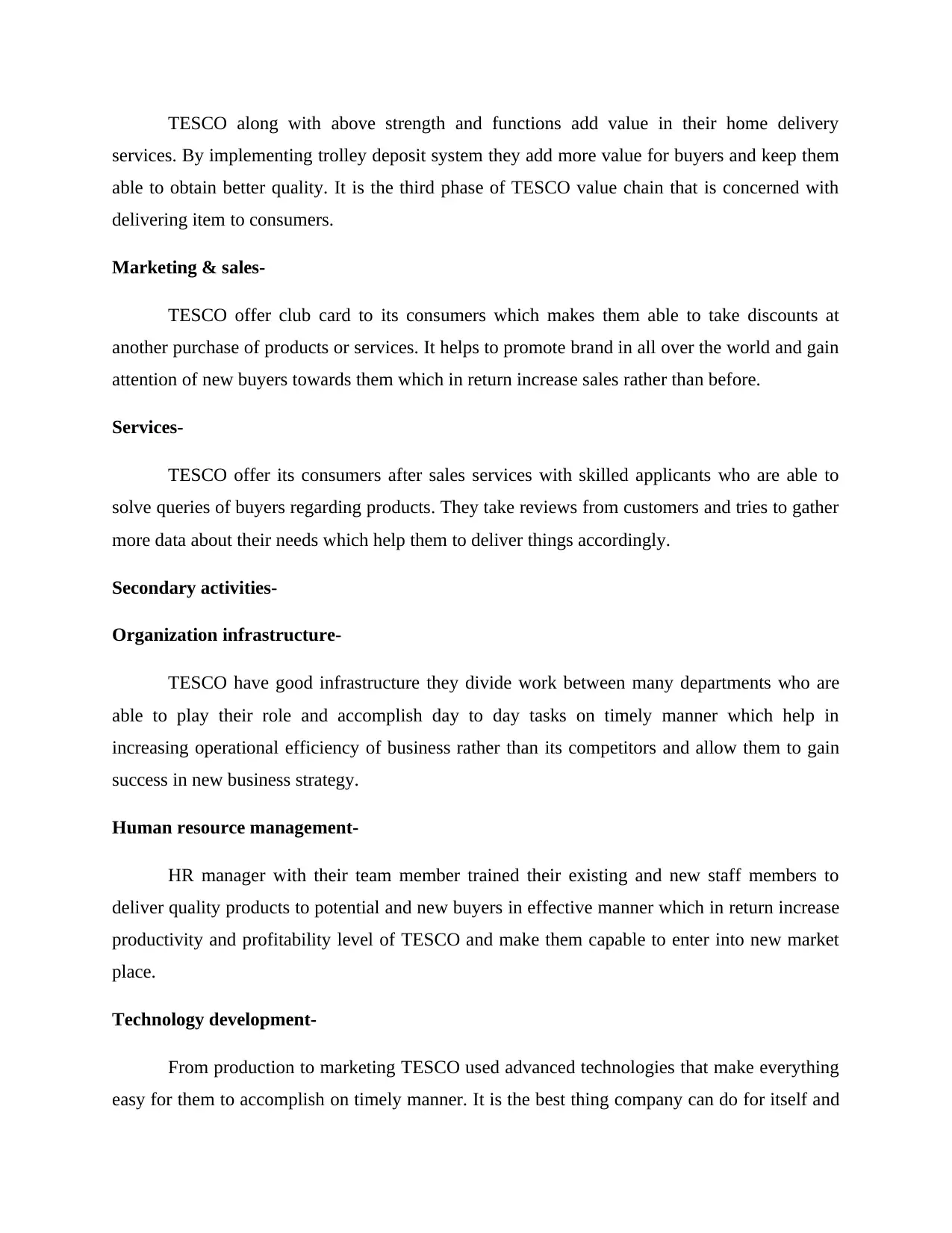
TESCO along with above strength and functions add value in their home delivery
services. By implementing trolley deposit system they add more value for buyers and keep them
able to obtain better quality. It is the third phase of TESCO value chain that is concerned with
delivering item to consumers.
Marketing & sales-
TESCO offer club card to its consumers which makes them able to take discounts at
another purchase of products or services. It helps to promote brand in all over the world and gain
attention of new buyers towards them which in return increase sales rather than before.
Services-
TESCO offer its consumers after sales services with skilled applicants who are able to
solve queries of buyers regarding products. They take reviews from customers and tries to gather
more data about their needs which help them to deliver things accordingly.
Secondary activities-
Organization infrastructure-
TESCO have good infrastructure they divide work between many departments who are
able to play their role and accomplish day to day tasks on timely manner which help in
increasing operational efficiency of business rather than its competitors and allow them to gain
success in new business strategy.
Human resource management-
HR manager with their team member trained their existing and new staff members to
deliver quality products to potential and new buyers in effective manner which in return increase
productivity and profitability level of TESCO and make them capable to enter into new market
place.
Technology development-
From production to marketing TESCO used advanced technologies that make everything
easy for them to accomplish on timely manner. It is the best thing company can do for itself and
services. By implementing trolley deposit system they add more value for buyers and keep them
able to obtain better quality. It is the third phase of TESCO value chain that is concerned with
delivering item to consumers.
Marketing & sales-
TESCO offer club card to its consumers which makes them able to take discounts at
another purchase of products or services. It helps to promote brand in all over the world and gain
attention of new buyers towards them which in return increase sales rather than before.
Services-
TESCO offer its consumers after sales services with skilled applicants who are able to
solve queries of buyers regarding products. They take reviews from customers and tries to gather
more data about their needs which help them to deliver things accordingly.
Secondary activities-
Organization infrastructure-
TESCO have good infrastructure they divide work between many departments who are
able to play their role and accomplish day to day tasks on timely manner which help in
increasing operational efficiency of business rather than its competitors and allow them to gain
success in new business strategy.
Human resource management-
HR manager with their team member trained their existing and new staff members to
deliver quality products to potential and new buyers in effective manner which in return increase
productivity and profitability level of TESCO and make them capable to enter into new market
place.
Technology development-
From production to marketing TESCO used advanced technologies that make everything
easy for them to accomplish on timely manner. It is the best thing company can do for itself and
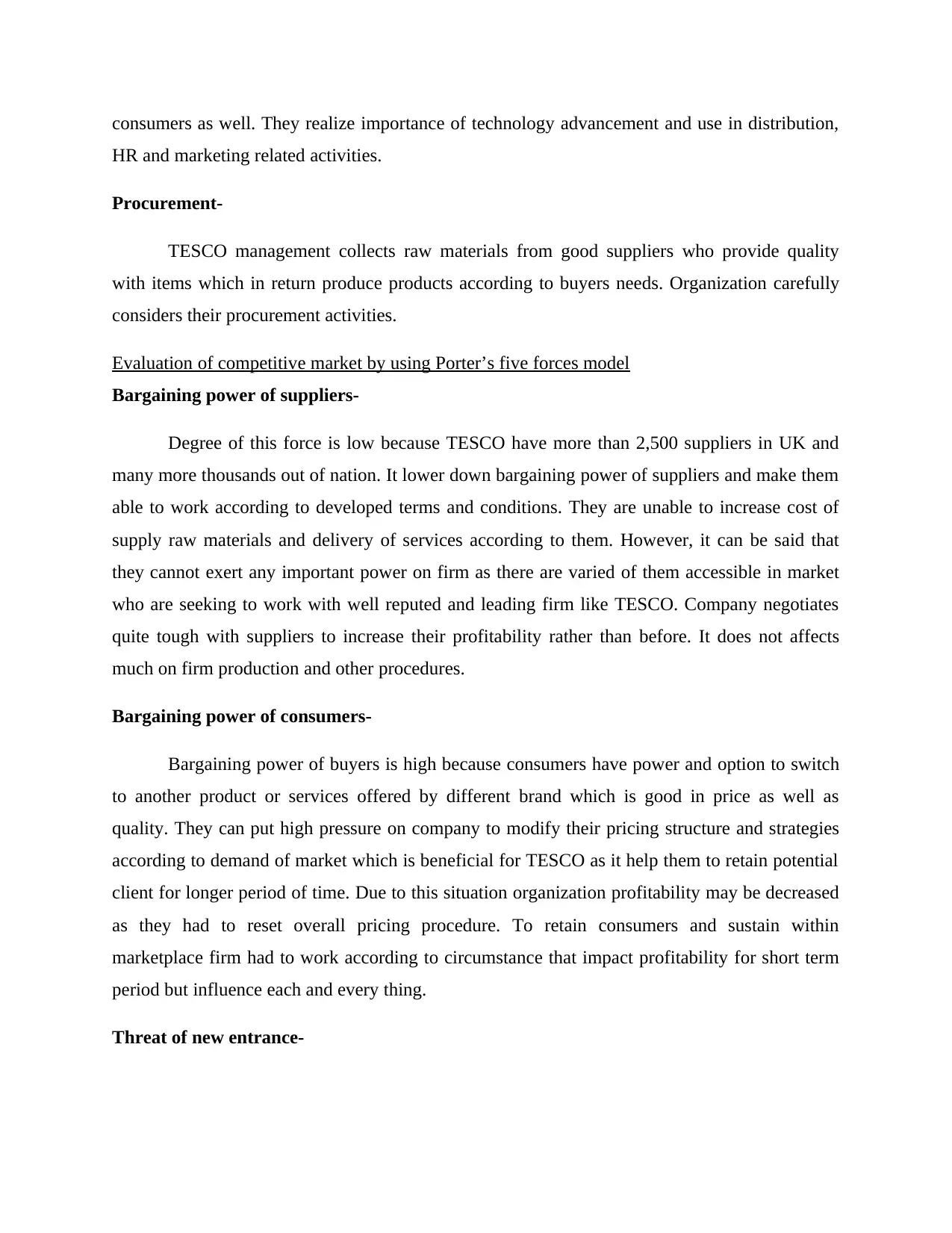
consumers as well. They realize importance of technology advancement and use in distribution,
HR and marketing related activities.
Procurement-
TESCO management collects raw materials from good suppliers who provide quality
with items which in return produce products according to buyers needs. Organization carefully
considers their procurement activities.
Evaluation of competitive market by using Porter’s five forces model
Bargaining power of suppliers-
Degree of this force is low because TESCO have more than 2,500 suppliers in UK and
many more thousands out of nation. It lower down bargaining power of suppliers and make them
able to work according to developed terms and conditions. They are unable to increase cost of
supply raw materials and delivery of services according to them. However, it can be said that
they cannot exert any important power on firm as there are varied of them accessible in market
who are seeking to work with well reputed and leading firm like TESCO. Company negotiates
quite tough with suppliers to increase their profitability rather than before. It does not affects
much on firm production and other procedures.
Bargaining power of consumers-
Bargaining power of buyers is high because consumers have power and option to switch
to another product or services offered by different brand which is good in price as well as
quality. They can put high pressure on company to modify their pricing structure and strategies
according to demand of market which is beneficial for TESCO as it help them to retain potential
client for longer period of time. Due to this situation organization profitability may be decreased
as they had to reset overall pricing procedure. To retain consumers and sustain within
marketplace firm had to work according to circumstance that impact profitability for short term
period but influence each and every thing.
Threat of new entrance-
HR and marketing related activities.
Procurement-
TESCO management collects raw materials from good suppliers who provide quality
with items which in return produce products according to buyers needs. Organization carefully
considers their procurement activities.
Evaluation of competitive market by using Porter’s five forces model
Bargaining power of suppliers-
Degree of this force is low because TESCO have more than 2,500 suppliers in UK and
many more thousands out of nation. It lower down bargaining power of suppliers and make them
able to work according to developed terms and conditions. They are unable to increase cost of
supply raw materials and delivery of services according to them. However, it can be said that
they cannot exert any important power on firm as there are varied of them accessible in market
who are seeking to work with well reputed and leading firm like TESCO. Company negotiates
quite tough with suppliers to increase their profitability rather than before. It does not affects
much on firm production and other procedures.
Bargaining power of consumers-
Bargaining power of buyers is high because consumers have power and option to switch
to another product or services offered by different brand which is good in price as well as
quality. They can put high pressure on company to modify their pricing structure and strategies
according to demand of market which is beneficial for TESCO as it help them to retain potential
client for longer period of time. Due to this situation organization profitability may be decreased
as they had to reset overall pricing procedure. To retain consumers and sustain within
marketplace firm had to work according to circumstance that impact profitability for short term
period but influence each and every thing.
Threat of new entrance-
Secure Best Marks with AI Grader
Need help grading? Try our AI Grader for instant feedback on your assignments.
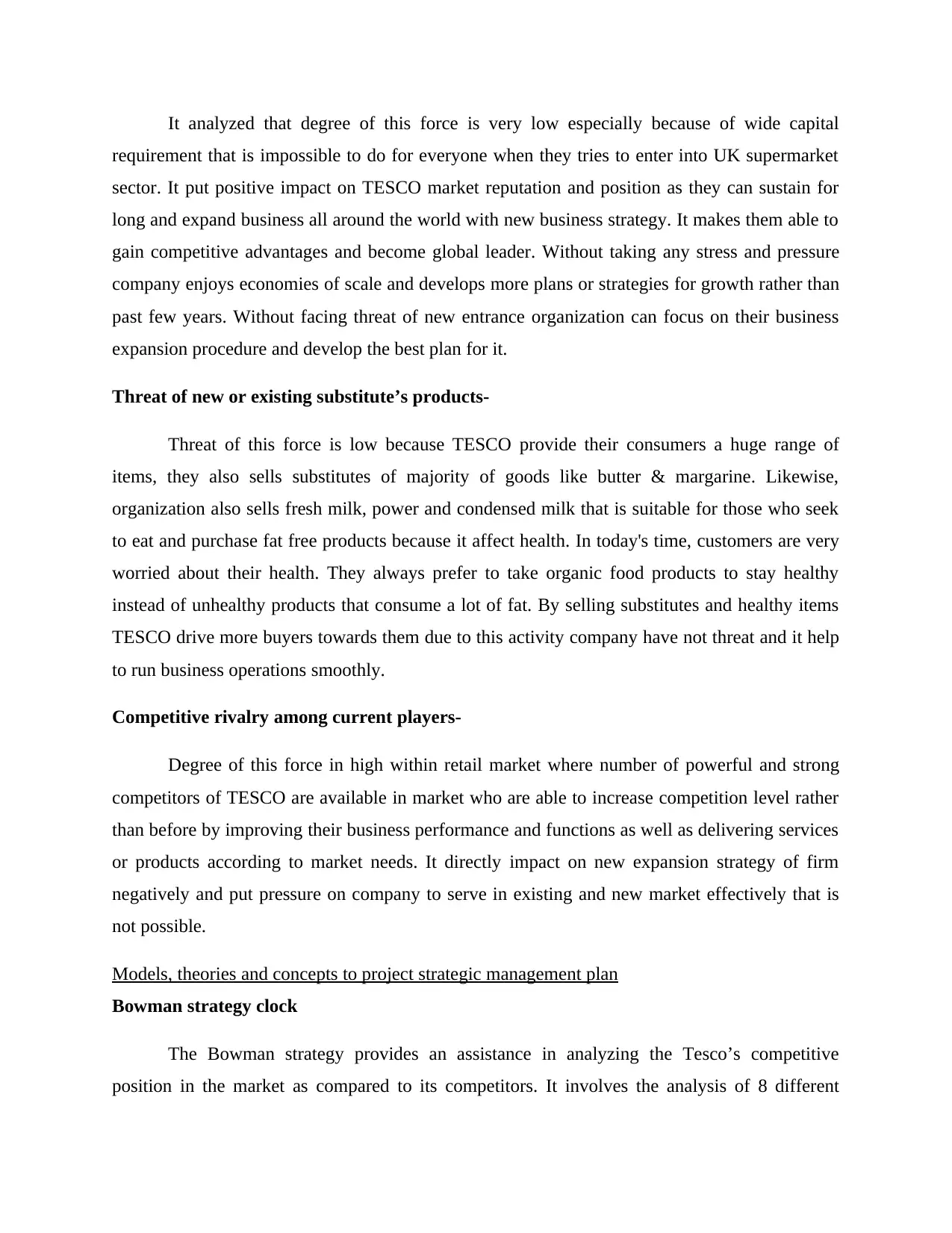
It analyzed that degree of this force is very low especially because of wide capital
requirement that is impossible to do for everyone when they tries to enter into UK supermarket
sector. It put positive impact on TESCO market reputation and position as they can sustain for
long and expand business all around the world with new business strategy. It makes them able to
gain competitive advantages and become global leader. Without taking any stress and pressure
company enjoys economies of scale and develops more plans or strategies for growth rather than
past few years. Without facing threat of new entrance organization can focus on their business
expansion procedure and develop the best plan for it.
Threat of new or existing substitute’s products-
Threat of this force is low because TESCO provide their consumers a huge range of
items, they also sells substitutes of majority of goods like butter & margarine. Likewise,
organization also sells fresh milk, power and condensed milk that is suitable for those who seek
to eat and purchase fat free products because it affect health. In today's time, customers are very
worried about their health. They always prefer to take organic food products to stay healthy
instead of unhealthy products that consume a lot of fat. By selling substitutes and healthy items
TESCO drive more buyers towards them due to this activity company have not threat and it help
to run business operations smoothly.
Competitive rivalry among current players-
Degree of this force in high within retail market where number of powerful and strong
competitors of TESCO are available in market who are able to increase competition level rather
than before by improving their business performance and functions as well as delivering services
or products according to market needs. It directly impact on new expansion strategy of firm
negatively and put pressure on company to serve in existing and new market effectively that is
not possible.
Models, theories and concepts to project strategic management plan
Bowman strategy clock
The Bowman strategy provides an assistance in analyzing the Tesco’s competitive
position in the market as compared to its competitors. It involves the analysis of 8 different
requirement that is impossible to do for everyone when they tries to enter into UK supermarket
sector. It put positive impact on TESCO market reputation and position as they can sustain for
long and expand business all around the world with new business strategy. It makes them able to
gain competitive advantages and become global leader. Without taking any stress and pressure
company enjoys economies of scale and develops more plans or strategies for growth rather than
past few years. Without facing threat of new entrance organization can focus on their business
expansion procedure and develop the best plan for it.
Threat of new or existing substitute’s products-
Threat of this force is low because TESCO provide their consumers a huge range of
items, they also sells substitutes of majority of goods like butter & margarine. Likewise,
organization also sells fresh milk, power and condensed milk that is suitable for those who seek
to eat and purchase fat free products because it affect health. In today's time, customers are very
worried about their health. They always prefer to take organic food products to stay healthy
instead of unhealthy products that consume a lot of fat. By selling substitutes and healthy items
TESCO drive more buyers towards them due to this activity company have not threat and it help
to run business operations smoothly.
Competitive rivalry among current players-
Degree of this force in high within retail market where number of powerful and strong
competitors of TESCO are available in market who are able to increase competition level rather
than before by improving their business performance and functions as well as delivering services
or products according to market needs. It directly impact on new expansion strategy of firm
negatively and put pressure on company to serve in existing and new market effectively that is
not possible.
Models, theories and concepts to project strategic management plan
Bowman strategy clock
The Bowman strategy provides an assistance in analyzing the Tesco’s competitive
position in the market as compared to its competitors. It involves the analysis of 8 different

strategies. This model helps in integrative analysis of the company and these strategies denotes
the strategic position of Tesco.
Low price and low value added: This is not the very competitive position of the business
as product is not differentiated and also customers will perceive the lower value even the though
the price is low (Desai, 2019). It is known as the bargain-based strategy. Under this, to be
competitive means to be as cheap as possible so that on one else can undercut it. Tesco provides
low price products but not cheap products.
Low price: It is a strategy of cost minimization which is required to be successful and is
associated with the economies of scale. But the profit margin of each product is low but the high
volume of output can create higher overall profits. This strategy will be good for Tesco for
attracting customers which is also been followed by other competitors.
Hybrid: This position involves the few elements of price in respect to competition and
some elements of product differentiation. The aim is to persuade the customers that the company
is providing the good value-added product through the combination of both price and product
differentiation.Tesco has a very low price and does take up steps to reinvest in the low-price
factor and which is one of the reasons of its Leadership.
Differentiation: This strategy aims at offering customers the highest level of perceived
value through high quality ad differentiated products with strong brand awareness.Tesco
Differentiates itself with their main objective of low price offered to customers with an added
value services provided as it keeps in mind the customers their main focus.
Focused differentiation: This positions the product at the highest price level so that
customers buy the product because of its high perceived value (Helmold, 2020). This is mainly
for luxury brand and cannot be applied to Tesco.
Risky high margins: It is the high-risk strategy which is doomed to failure eventually.
Businesses set the prices high without any additional perceived value. It is risky because
customers may not buy products at high prices. Thus, this strategy might not be useful.
Monopoly pricing: Under this, there is only single offering and customers have no choice
but to buy the product. But this is not the case in Tesco.
the strategic position of Tesco.
Low price and low value added: This is not the very competitive position of the business
as product is not differentiated and also customers will perceive the lower value even the though
the price is low (Desai, 2019). It is known as the bargain-based strategy. Under this, to be
competitive means to be as cheap as possible so that on one else can undercut it. Tesco provides
low price products but not cheap products.
Low price: It is a strategy of cost minimization which is required to be successful and is
associated with the economies of scale. But the profit margin of each product is low but the high
volume of output can create higher overall profits. This strategy will be good for Tesco for
attracting customers which is also been followed by other competitors.
Hybrid: This position involves the few elements of price in respect to competition and
some elements of product differentiation. The aim is to persuade the customers that the company
is providing the good value-added product through the combination of both price and product
differentiation.Tesco has a very low price and does take up steps to reinvest in the low-price
factor and which is one of the reasons of its Leadership.
Differentiation: This strategy aims at offering customers the highest level of perceived
value through high quality ad differentiated products with strong brand awareness.Tesco
Differentiates itself with their main objective of low price offered to customers with an added
value services provided as it keeps in mind the customers their main focus.
Focused differentiation: This positions the product at the highest price level so that
customers buy the product because of its high perceived value (Helmold, 2020). This is mainly
for luxury brand and cannot be applied to Tesco.
Risky high margins: It is the high-risk strategy which is doomed to failure eventually.
Businesses set the prices high without any additional perceived value. It is risky because
customers may not buy products at high prices. Thus, this strategy might not be useful.
Monopoly pricing: Under this, there is only single offering and customers have no choice
but to buy the product. But this is not the case in Tesco.
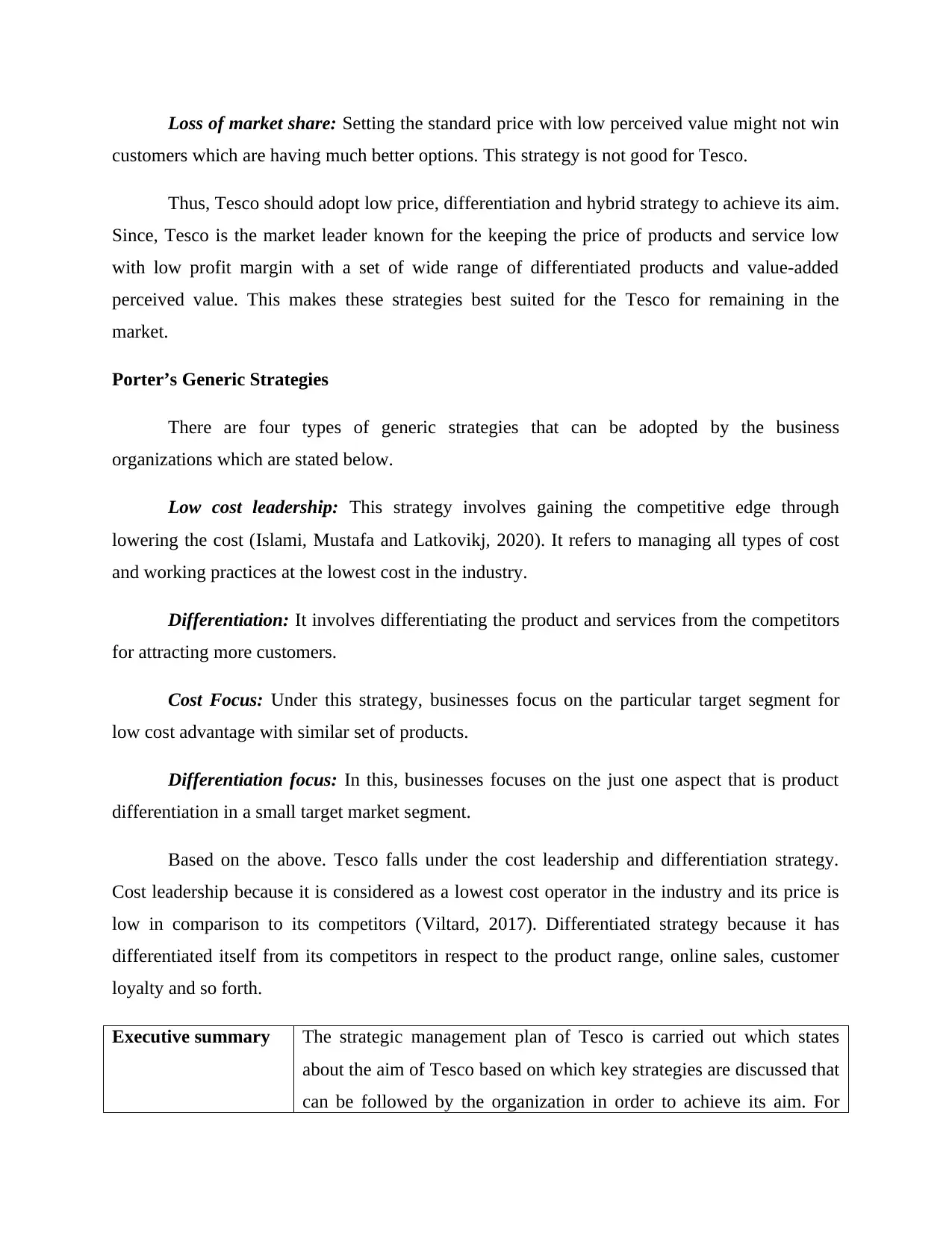
Loss of market share: Setting the standard price with low perceived value might not win
customers which are having much better options. This strategy is not good for Tesco.
Thus, Tesco should adopt low price, differentiation and hybrid strategy to achieve its aim.
Since, Tesco is the market leader known for the keeping the price of products and service low
with low profit margin with a set of wide range of differentiated products and value-added
perceived value. This makes these strategies best suited for the Tesco for remaining in the
market.
Porter’s Generic Strategies
There are four types of generic strategies that can be adopted by the business
organizations which are stated below.
Low cost leadership: This strategy involves gaining the competitive edge through
lowering the cost (Islami, Mustafa and Latkovikj, 2020). It refers to managing all types of cost
and working practices at the lowest cost in the industry.
Differentiation: It involves differentiating the product and services from the competitors
for attracting more customers.
Cost Focus: Under this strategy, businesses focus on the particular target segment for
low cost advantage with similar set of products.
Differentiation focus: In this, businesses focuses on the just one aspect that is product
differentiation in a small target market segment.
Based on the above. Tesco falls under the cost leadership and differentiation strategy.
Cost leadership because it is considered as a lowest cost operator in the industry and its price is
low in comparison to its competitors (Viltard, 2017). Differentiated strategy because it has
differentiated itself from its competitors in respect to the product range, online sales, customer
loyalty and so forth.
Executive summary The strategic management plan of Tesco is carried out which states
about the aim of Tesco based on which key strategies are discussed that
can be followed by the organization in order to achieve its aim. For
customers which are having much better options. This strategy is not good for Tesco.
Thus, Tesco should adopt low price, differentiation and hybrid strategy to achieve its aim.
Since, Tesco is the market leader known for the keeping the price of products and service low
with low profit margin with a set of wide range of differentiated products and value-added
perceived value. This makes these strategies best suited for the Tesco for remaining in the
market.
Porter’s Generic Strategies
There are four types of generic strategies that can be adopted by the business
organizations which are stated below.
Low cost leadership: This strategy involves gaining the competitive edge through
lowering the cost (Islami, Mustafa and Latkovikj, 2020). It refers to managing all types of cost
and working practices at the lowest cost in the industry.
Differentiation: It involves differentiating the product and services from the competitors
for attracting more customers.
Cost Focus: Under this strategy, businesses focus on the particular target segment for
low cost advantage with similar set of products.
Differentiation focus: In this, businesses focuses on the just one aspect that is product
differentiation in a small target market segment.
Based on the above. Tesco falls under the cost leadership and differentiation strategy.
Cost leadership because it is considered as a lowest cost operator in the industry and its price is
low in comparison to its competitors (Viltard, 2017). Differentiated strategy because it has
differentiated itself from its competitors in respect to the product range, online sales, customer
loyalty and so forth.
Executive summary The strategic management plan of Tesco is carried out which states
about the aim of Tesco based on which key strategies are discussed that
can be followed by the organization in order to achieve its aim. For
Paraphrase This Document
Need a fresh take? Get an instant paraphrase of this document with our AI Paraphraser
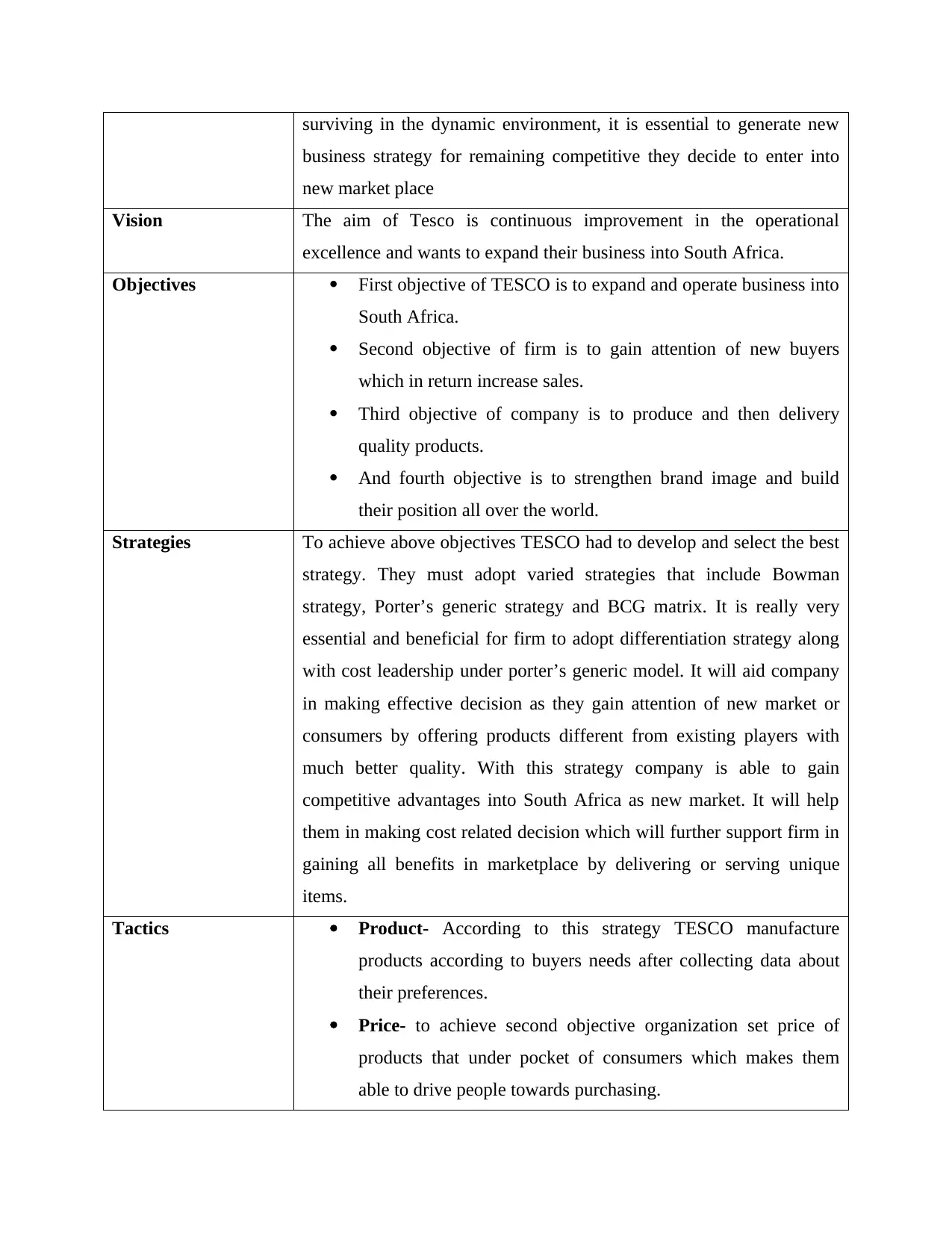
surviving in the dynamic environment, it is essential to generate new
business strategy for remaining competitive they decide to enter into
new market place
Vision The aim of Tesco is continuous improvement in the operational
excellence and wants to expand their business into South Africa.
Objectives First objective of TESCO is to expand and operate business into
South Africa.
Second objective of firm is to gain attention of new buyers
which in return increase sales.
Third objective of company is to produce and then delivery
quality products.
And fourth objective is to strengthen brand image and build
their position all over the world.
Strategies To achieve above objectives TESCO had to develop and select the best
strategy. They must adopt varied strategies that include Bowman
strategy, Porter’s generic strategy and BCG matrix. It is really very
essential and beneficial for firm to adopt differentiation strategy along
with cost leadership under porter’s generic model. It will aid company
in making effective decision as they gain attention of new market or
consumers by offering products different from existing players with
much better quality. With this strategy company is able to gain
competitive advantages into South Africa as new market. It will help
them in making cost related decision which will further support firm in
gaining all benefits in marketplace by delivering or serving unique
items.
Tactics Product- According to this strategy TESCO manufacture
products according to buyers needs after collecting data about
their preferences.
Price- to achieve second objective organization set price of
products that under pocket of consumers which makes them
able to drive people towards purchasing.
business strategy for remaining competitive they decide to enter into
new market place
Vision The aim of Tesco is continuous improvement in the operational
excellence and wants to expand their business into South Africa.
Objectives First objective of TESCO is to expand and operate business into
South Africa.
Second objective of firm is to gain attention of new buyers
which in return increase sales.
Third objective of company is to produce and then delivery
quality products.
And fourth objective is to strengthen brand image and build
their position all over the world.
Strategies To achieve above objectives TESCO had to develop and select the best
strategy. They must adopt varied strategies that include Bowman
strategy, Porter’s generic strategy and BCG matrix. It is really very
essential and beneficial for firm to adopt differentiation strategy along
with cost leadership under porter’s generic model. It will aid company
in making effective decision as they gain attention of new market or
consumers by offering products different from existing players with
much better quality. With this strategy company is able to gain
competitive advantages into South Africa as new market. It will help
them in making cost related decision which will further support firm in
gaining all benefits in marketplace by delivering or serving unique
items.
Tactics Product- According to this strategy TESCO manufacture
products according to buyers needs after collecting data about
their preferences.
Price- to achieve second objective organization set price of
products that under pocket of consumers which makes them
able to drive people towards purchasing.
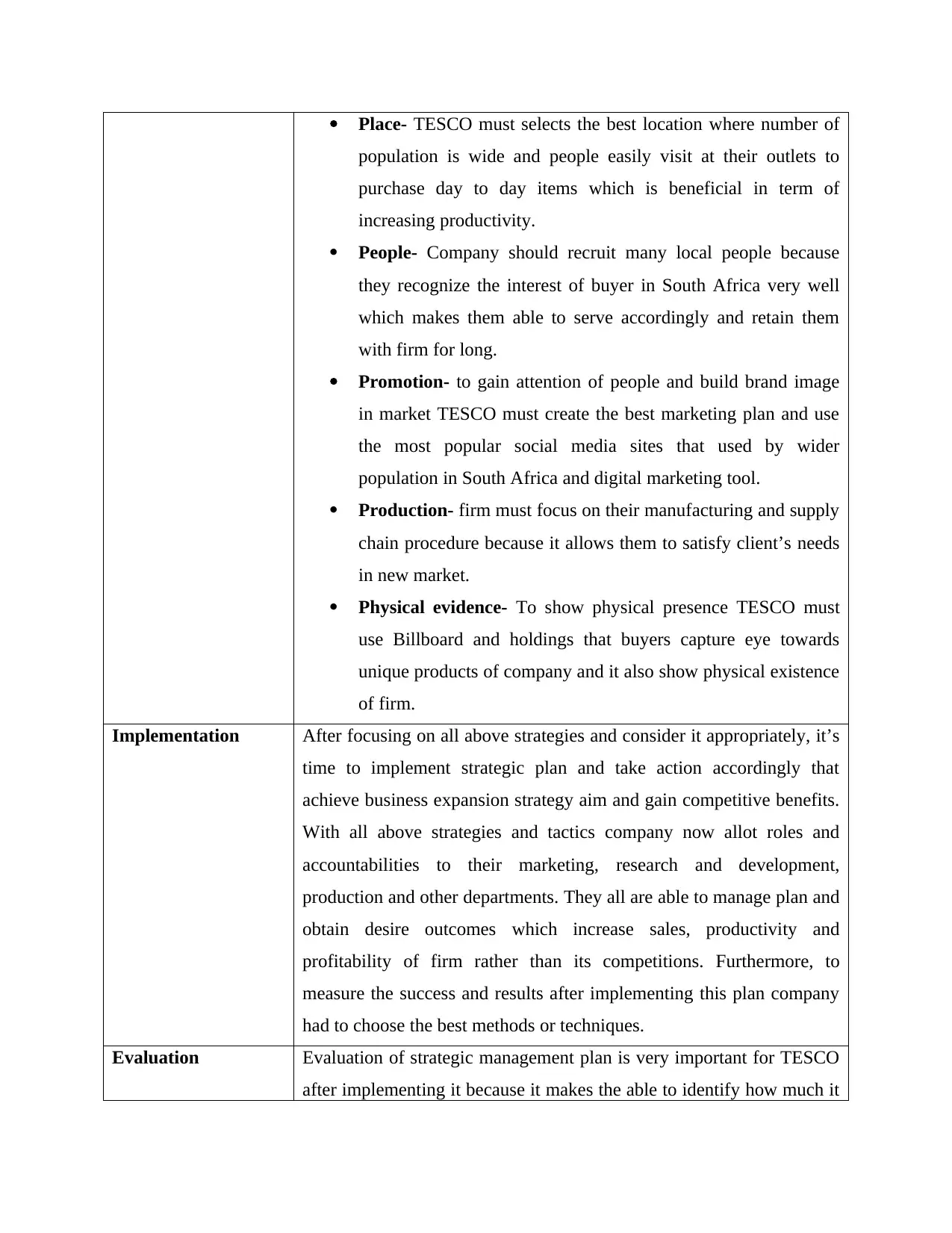
Place- TESCO must selects the best location where number of
population is wide and people easily visit at their outlets to
purchase day to day items which is beneficial in term of
increasing productivity.
People- Company should recruit many local people because
they recognize the interest of buyer in South Africa very well
which makes them able to serve accordingly and retain them
with firm for long.
Promotion- to gain attention of people and build brand image
in market TESCO must create the best marketing plan and use
the most popular social media sites that used by wider
population in South Africa and digital marketing tool.
Production- firm must focus on their manufacturing and supply
chain procedure because it allows them to satisfy client’s needs
in new market.
Physical evidence- To show physical presence TESCO must
use Billboard and holdings that buyers capture eye towards
unique products of company and it also show physical existence
of firm.
Implementation After focusing on all above strategies and consider it appropriately, it’s
time to implement strategic plan and take action accordingly that
achieve business expansion strategy aim and gain competitive benefits.
With all above strategies and tactics company now allot roles and
accountabilities to their marketing, research and development,
production and other departments. They all are able to manage plan and
obtain desire outcomes which increase sales, productivity and
profitability of firm rather than its competitions. Furthermore, to
measure the success and results after implementing this plan company
had to choose the best methods or techniques.
Evaluation Evaluation of strategic management plan is very important for TESCO
after implementing it because it makes the able to identify how much it
population is wide and people easily visit at their outlets to
purchase day to day items which is beneficial in term of
increasing productivity.
People- Company should recruit many local people because
they recognize the interest of buyer in South Africa very well
which makes them able to serve accordingly and retain them
with firm for long.
Promotion- to gain attention of people and build brand image
in market TESCO must create the best marketing plan and use
the most popular social media sites that used by wider
population in South Africa and digital marketing tool.
Production- firm must focus on their manufacturing and supply
chain procedure because it allows them to satisfy client’s needs
in new market.
Physical evidence- To show physical presence TESCO must
use Billboard and holdings that buyers capture eye towards
unique products of company and it also show physical existence
of firm.
Implementation After focusing on all above strategies and consider it appropriately, it’s
time to implement strategic plan and take action accordingly that
achieve business expansion strategy aim and gain competitive benefits.
With all above strategies and tactics company now allot roles and
accountabilities to their marketing, research and development,
production and other departments. They all are able to manage plan and
obtain desire outcomes which increase sales, productivity and
profitability of firm rather than its competitions. Furthermore, to
measure the success and results after implementing this plan company
had to choose the best methods or techniques.
Evaluation Evaluation of strategic management plan is very important for TESCO
after implementing it because it makes the able to identify how much it
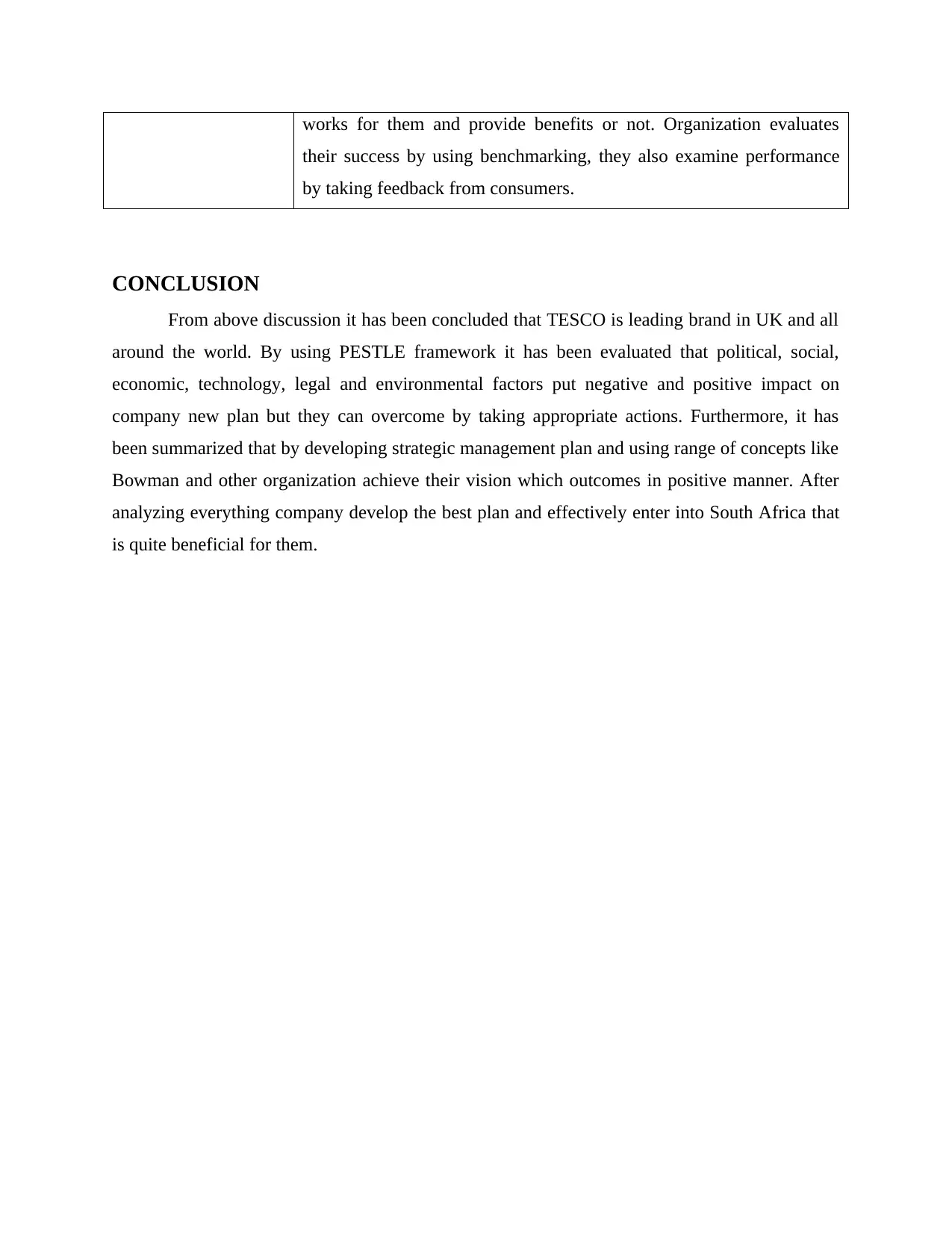
works for them and provide benefits or not. Organization evaluates
their success by using benchmarking, they also examine performance
by taking feedback from consumers.
CONCLUSION
From above discussion it has been concluded that TESCO is leading brand in UK and all
around the world. By using PESTLE framework it has been evaluated that political, social,
economic, technology, legal and environmental factors put negative and positive impact on
company new plan but they can overcome by taking appropriate actions. Furthermore, it has
been summarized that by developing strategic management plan and using range of concepts like
Bowman and other organization achieve their vision which outcomes in positive manner. After
analyzing everything company develop the best plan and effectively enter into South Africa that
is quite beneficial for them.
their success by using benchmarking, they also examine performance
by taking feedback from consumers.
CONCLUSION
From above discussion it has been concluded that TESCO is leading brand in UK and all
around the world. By using PESTLE framework it has been evaluated that political, social,
economic, technology, legal and environmental factors put negative and positive impact on
company new plan but they can overcome by taking appropriate actions. Furthermore, it has
been summarized that by developing strategic management plan and using range of concepts like
Bowman and other organization achieve their vision which outcomes in positive manner. After
analyzing everything company develop the best plan and effectively enter into South Africa that
is quite beneficial for them.
Secure Best Marks with AI Grader
Need help grading? Try our AI Grader for instant feedback on your assignments.

REFERENCES
Book and Journals
Berlingieri, G., Breinlich, H. and Dhingra, S., 2018. The impact of trade agreements on
consumer welfare—evidence from the eu common external trade policy. Journal of the
European Economic Association. 16(6). pp.1881-1928.
Caulley, S.L., 2017. The Next Frontier to LGBT Equality: Securing Workplace-Discrimination
Protections. U. Ill. L. Rev., p.909.
Desai, C., 2019. Strategy and Strategic Management'. Management for Scientists. Emerald
Publishing Limited. pp.65-84.
Helmold, M., 2020. Negotiations as Integral Part of the Corporate Strategy. In Successful
International Negotiations (pp. 45-57). Springer, Cham.
Islami, X., Mustafa, N. and Latkovikj, M.T., 2020. Linking Porter’s generic strategies to firm
performance. Future Business Journal. 6(1). p.3.
Jonah, U.I., 2018. The Influence of Transaction Costs on the Business Performances of Tesco
Supermarket. International Journal of Business and Social Science. 9(5).
Lythreatis, S., Mostafa, A.M.S. and Wang, X., 2019. Participative leadership and organizational
identification in SMEs in the MENA Region: Testing the roles of CSR perceptions and
pride in membership. Journal of Business Ethics, 156(3), pp.635-650.
Mahadea, D. and Kaseeram, I., 2018. Impact of unemployment and income on entrepreneurship
in post-apartheid South Africa: 1994–2015. The Southern African Journal of
Entrepreneurship and Small Business Management. 10(1). pp.1-9.
Ryke, L., 2019. Consumer buying behaviour in online fashion retail: a study of South African
millennial males (Doctoral dissertation, Stellenbosch: Stellenbosch University).
Viltard, L.A., 2017. Strategic mistakes (AVOIDABLE): the topicality of Michel Porter’s generic
strategies. Independent Journal of Management & Production. 8(2). pp.474-497.
Wang, J and et.al., 2017. Overview of compressed air energy storage and technology
development. Energies. 10(7). p.991.
Online
PESTLE analysis. 2018. [Online]. Available through: < https://www.marketingtutor.net/tesco-
pestle-analysis/>
Book and Journals
Berlingieri, G., Breinlich, H. and Dhingra, S., 2018. The impact of trade agreements on
consumer welfare—evidence from the eu common external trade policy. Journal of the
European Economic Association. 16(6). pp.1881-1928.
Caulley, S.L., 2017. The Next Frontier to LGBT Equality: Securing Workplace-Discrimination
Protections. U. Ill. L. Rev., p.909.
Desai, C., 2019. Strategy and Strategic Management'. Management for Scientists. Emerald
Publishing Limited. pp.65-84.
Helmold, M., 2020. Negotiations as Integral Part of the Corporate Strategy. In Successful
International Negotiations (pp. 45-57). Springer, Cham.
Islami, X., Mustafa, N. and Latkovikj, M.T., 2020. Linking Porter’s generic strategies to firm
performance. Future Business Journal. 6(1). p.3.
Jonah, U.I., 2018. The Influence of Transaction Costs on the Business Performances of Tesco
Supermarket. International Journal of Business and Social Science. 9(5).
Lythreatis, S., Mostafa, A.M.S. and Wang, X., 2019. Participative leadership and organizational
identification in SMEs in the MENA Region: Testing the roles of CSR perceptions and
pride in membership. Journal of Business Ethics, 156(3), pp.635-650.
Mahadea, D. and Kaseeram, I., 2018. Impact of unemployment and income on entrepreneurship
in post-apartheid South Africa: 1994–2015. The Southern African Journal of
Entrepreneurship and Small Business Management. 10(1). pp.1-9.
Ryke, L., 2019. Consumer buying behaviour in online fashion retail: a study of South African
millennial males (Doctoral dissertation, Stellenbosch: Stellenbosch University).
Viltard, L.A., 2017. Strategic mistakes (AVOIDABLE): the topicality of Michel Porter’s generic
strategies. Independent Journal of Management & Production. 8(2). pp.474-497.
Wang, J and et.al., 2017. Overview of compressed air energy storage and technology
development. Energies. 10(7). p.991.
Online
PESTLE analysis. 2018. [Online]. Available through: < https://www.marketingtutor.net/tesco-
pestle-analysis/>
1 out of 17
Related Documents
Your All-in-One AI-Powered Toolkit for Academic Success.
+13062052269
info@desklib.com
Available 24*7 on WhatsApp / Email
![[object Object]](/_next/static/media/star-bottom.7253800d.svg)
Unlock your academic potential
© 2024 | Zucol Services PVT LTD | All rights reserved.





